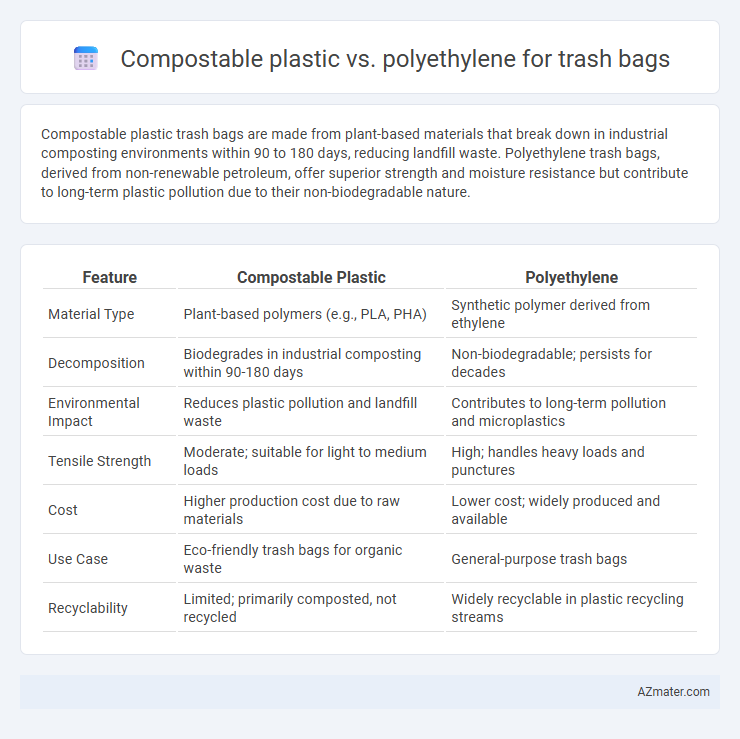Compostable plastic trash bags are made from plant-based materials that break down in industrial composting environments within 90 to 180 days, reducing landfill waste. Polyethylene trash bags, derived from non-renewable petroleum, offer superior strength and moisture resistance but contribute to long-term plastic pollution due to their non-biodegradable nature.
Table of Comparison
| Feature | Compostable Plastic | Polyethylene |
|---|---|---|
| Material Type | Plant-based polymers (e.g., PLA, PHA) | Synthetic polymer derived from ethylene |
| Decomposition | Biodegrades in industrial composting within 90-180 days | Non-biodegradable; persists for decades |
| Environmental Impact | Reduces plastic pollution and landfill waste | Contributes to long-term pollution and microplastics |
| Tensile Strength | Moderate; suitable for light to medium loads | High; handles heavy loads and punctures |
| Cost | Higher production cost due to raw materials | Lower cost; widely produced and available |
| Use Case | Eco-friendly trash bags for organic waste | General-purpose trash bags |
| Recyclability | Limited; primarily composted, not recycled | Widely recyclable in plastic recycling streams |
Introduction to Compostable Plastics and Polyethylene
Compostable plastics are derived from renewable biomass sources like corn starch, designed to break down into non-toxic components under industrial composting conditions within 90 to 180 days. Polyethylene, a petroleum-based polymer, is the most common plastic used in trash bags due to its durability, flexibility, and resistance to moisture and chemicals. Unlike polyethylene, compostable plastics offer an environmentally friendly alternative by reducing reliance on fossil fuels and minimizing plastic pollution through biodegradability.
Understanding the Composition of Trash Bags
Compostable plastic trash bags are primarily made from plant-based polymers such as polylactic acid (PLA) or starch blends, designed to break down under industrial composting conditions, reducing environmental impact. Polyethylene trash bags consist of long chains of ethylene monomers derived from non-renewable fossil fuels, offering high durability and resistance to tearing but persisting in landfills for hundreds of years. Understanding these material compositions highlights the trade-off between biodegradability and strength, influencing consumer choice based on environmental priorities and practical needs.
Environmental Impact: Compostable vs Polyethylene
Compostable plastic trash bags break down into natural elements within a few months under industrial composting conditions, significantly reducing long-term environmental pollution compared to polyethylene bags. Polyethylene, a petroleum-based plastic, can persist in landfills and oceans for hundreds of years, contributing to microplastic contamination and greenhouse gas emissions. Choosing compostable bags supports waste management systems aiming to minimize carbon footprints and promote soil health through biodegradation.
Degradation and Biodegradability Explained
Compostable plastic trash bags are designed to break down through microbial activity within composting environments, typically degrading fully within 90 to 180 days under optimal conditions, whereas polyethylene bags can persist in landfills for hundreds of years due to their resistance to microbial decomposition. Biodegradability in compostable plastics is enhanced by additives and natural materials like polylactic acid (PLA), enabling them to return to organic matter without leaving toxic residues. Polyethylene, a petroleum-based polymer, lacks these properties, resulting in environmental concerns from long-term plastic pollution and limited natural breakdown.
Performance and Durability Comparison
Compostable plastic trash bags offer eco-friendly degradation but typically have lower tensile strength and are less resistant to punctures compared to polyethylene bags. Polyethylene trash bags excel in durability, providing superior tear resistance and flexibility, which makes them reliable for heavy or sharp waste. Performance-wise, polyethylene bags maintain integrity over extended use, while compostable options prioritize environmental benefits but may require gentler handling to prevent early breakdown.
Cost Analysis: Compostable Plastic vs Polyethylene Bags
Compostable plastic trash bags generally incur higher production and retail costs compared to polyethylene bags due to raw material expenses and specialized manufacturing processes. Polyethylene bags offer a cost-effective solution with widespread availability and low production costs, making them more affordable for large-scale use. However, the environmental disposal benefits of compostable plastics can offset initial costs through reduced landfill impact and potential waste management savings.
Disposal Methods and Infrastructure Requirements
Compostable plastic trash bags require industrial composting facilities with high heat and humidity to break down effectively, limiting their disposal options in regions lacking such infrastructure. Polyethylene trash bags are widely accepted in conventional landfills and can be incinerated for energy recovery, benefiting from established waste management systems. Proper sorting is critical to prevent contamination, as mixing compostable bags with polyethylene can hinder recycling and composting processes.
Regulatory Standards and Certifications
Compostable plastic trash bags must comply with stringent regulatory standards such as ASTM D6400 in the United States and EN 13432 in Europe, ensuring they break down safely in industrial composting environments without leaving harmful residues. Polyethylene trash bags, typically exempt from biodegradability certifications, are instead governed by material safety and recycling regulations like those from the EPA and ISO 14001 for environmental management. Certification labels such as the Seedling logo for compostables and resin identification codes for polyethylene provide consumers with trusted verification of environmental claims and proper disposal methods.
Consumer Perception and Market Trends
Consumers increasingly favor compostable plastic trash bags due to growing environmental awareness and demand for sustainable products, despite polyethylene's longer-established reliability and lower cost. Market trends indicate accelerated growth in the compostable plastic segment, driven by stricter regulations on single-use plastics and corporate commitments to reduce carbon footprints. Surveys reveal that while polyethylene bags dominate current market share, consumer preference is shifting toward biodegradable alternatives as eco-conscious values influence purchasing decisions.
Future Outlook: Innovations in Trash Bag Materials
Compostable plastic trash bags are gaining traction due to advancements in biopolymer technology, which enhance their biodegradability and strength, making them competitive with traditional polyethylene bags. Innovations such as enzyme-infused liners and plant-based additives are accelerating the breakdown process in industrial composting facilities while maintaining durability. The future outlook indicates a shift towards hybrid materials that combine the cost-effectiveness and resilience of polyethylene with the environmental benefits of compostable plastics, driven by increasing regulatory pressures and consumer demand for sustainable waste management solutions.

Infographic: Compostable plastic vs Polyethylene for Trash bag
 azmater.com
azmater.com